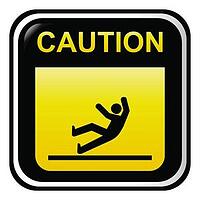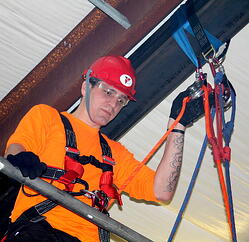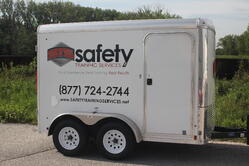Falls & Workplace Safety
According to OSHA's commonly used statistics, the leading cause of worker's deaths on construction sites were falls. In fact, 35% of total deaths in the field of construction for CY 2011 were from falls.
It is also OSHA's number two most frequently cited standard violation in FY 2011 (29 CFR 1926.501).
How can falls be reduced?
First, we must look at how OSHA requirements help with reducing these accidents. OSHA requires that fall protection be provided at elevations of four feet in general industry workplaces and six feet in the construction industry. In addition, OSHA requires that fall protection be provided when working over dangerous equipment and machinery, regardless of the fall distance.
 OSHA requires employers to provide working conditions that are free of known dangers. The company must provide required personal protective equipment at no cost to workers. Floors in work areas must be kept clean and dry (as much as possible).
OSHA requires employers to provide working conditions that are free of known dangers. The company must provide required personal protective equipment at no cost to workers. Floors in work areas must be kept clean and dry (as much as possible).
(Quoted from OSHA's website):
To prevent employees from being injured from falls, employers must:
- Guard every floor hole into which a worker can accidentally walk (using a railing and toe-board or a floor hole cover).
- Provide a guard rail and toe-board around every elevated open sided platform, floor or runway.
- Regardless of height, if a worker can fall into or onto dangerous machines or equipment (such as a vat of acid or a conveyor belt) employers must provide guardrails and toe-boards to prevent workers from falling and getting injured.
- Other means of fall protection that may be required on certain jobs include safety and harness and line, safety nets, stair railings and hand rails.

 OSHA wants to help reduce (hopefully eliminate) these accidents, and Safety Training Services, Inc. is here to facilitate as well.
OSHA wants to help reduce (hopefully eliminate) these accidents, and Safety Training Services, Inc. is here to facilitate as well.

 Flexibility and Mobility - training firms can conduct training in most venues and locales regardless of distance or accommodations. They are focused on getting the training done correctly and not on the “sacrifice” they are making for the company in terms of their other duties. Contracted Trainers carry literally suitcases of training equipment and materials that allows them to conduct a session in almost any situation, geographic location or audience.
Flexibility and Mobility - training firms can conduct training in most venues and locales regardless of distance or accommodations. They are focused on getting the training done correctly and not on the “sacrifice” they are making for the company in terms of their other duties. Contracted Trainers carry literally suitcases of training equipment and materials that allows them to conduct a session in almost any situation, geographic location or audience.